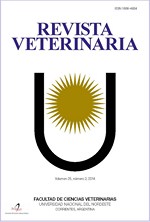Effect of two dilution temperatures on the quality of semen in cattle from zebu in the Peruvian Tropic
DOI:
https://doi.org/10.30972/vet.3416608Keywords:
Bull, sperm viability, cryopreservation, morphology, seminal freezingAbstract
The bull is a factor of genetic and economic importance in cattle breed, since the next generations will depend on it; therefore, the evaluation of the seminal quality and the cryopreservation of its genetic material are essential. The aim of the study was to evaluate the effect of two dilution temperatures on the quality of semen from zebuine cattle from the Peruvian Tropics. The samples were placed in a water bath at 34°C and the macroscopic and microscopic characteristics of semen were analyzed. Only the ejaculates with >60% motility and <20% abnormalities were processed, separating them into two treatments. T1 consisted of a 1:1 predilution at 34°C, followed by a final dilution of 30 minutes by adding the dilutor at 34°C. T2 consisted of a 1:1 predilution at 34°C and after 30 minutes of stabilization, refrigeration was carried out together with the dilutor, in order to carry out the final dilution at 5°C. The seminal quality was analyzed after 16 hours of refrigeration. The percentage of vitality in T1 (80.89%) was greater than in T2 (71.22%) (p<0.05), the positive reaction to the hypoosmotic problem was greater in T1 (71.11%) than in T2 (60%) (p<0.05). Acrosomal integrity and morphometric features did not vary according to treatments. In conclusion, the initial and final dilution at 34°C in Gyr bulls positively influences the semen quality before the freezing of semen packets.
Downloads
Downloads
Published
How to Cite
Issue
Section
License
Revista Veterinaria (Rev. Vet.) maintains a commitment to the policies of Open Access to scientific information, as it considers that both scientific publications as well as research investigations funded by public resources should circulate freely without restrictions. Revista Veterinaria (Rev. Vet.) ratifies the Open Access model in which scientific publications are made freely available at no cost online.











.jpg)
.jpg)



